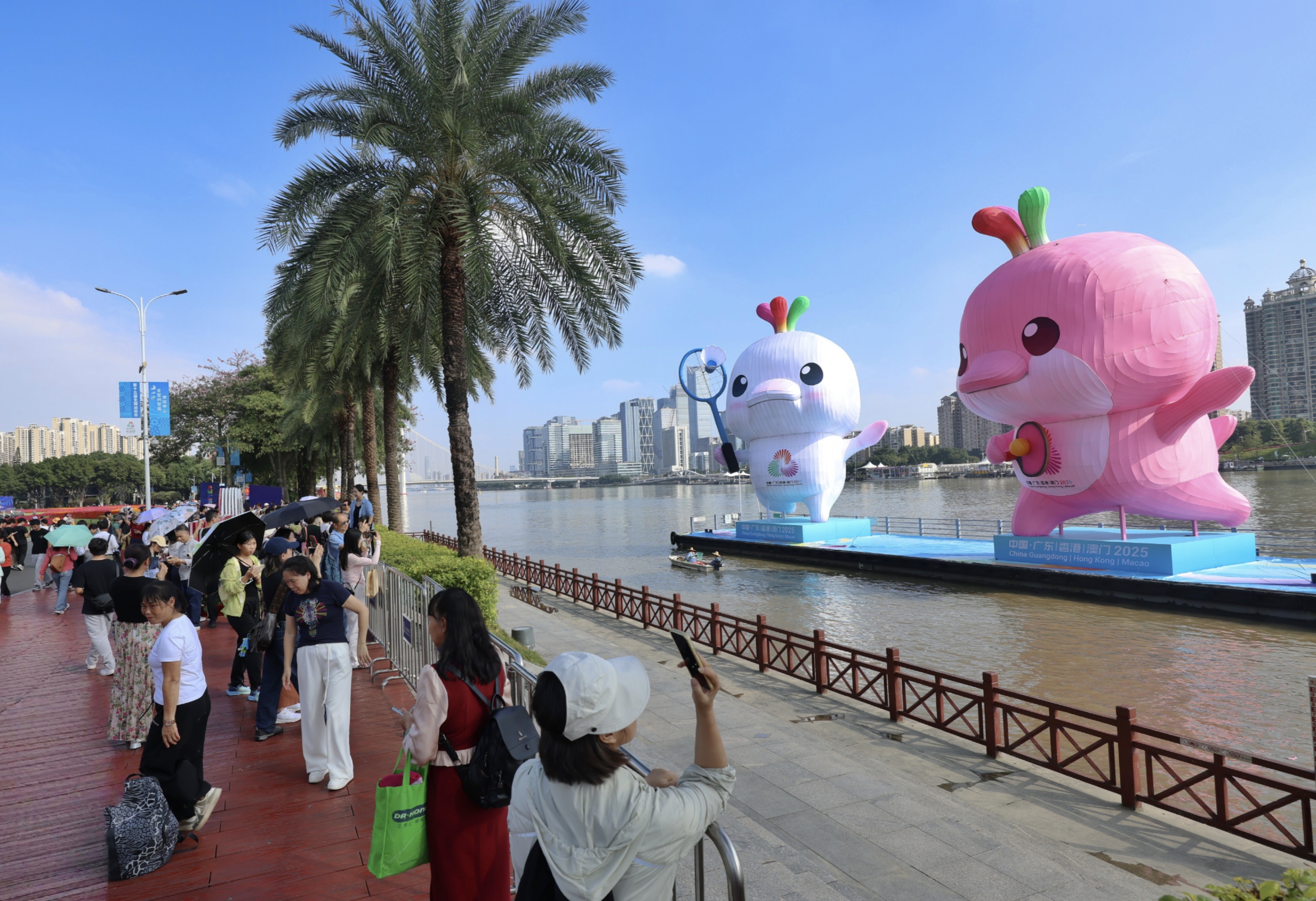
Through their headspins, high jumps and playful antics, the mascots Xi Yangyang and Le Rongrong, inspired by the Chinese white dolphin, have become the unexpected stars of the ongoing 15th National Games, stealing the show at venues across the three host regions.
Their design was led by Liu Pingyun, the mind behind the beloved Beijing Winter Olympics panda mascot, Bing Dwen Dwen. Liu explained the evolution: "Bing Dwen Dwen's barrel-shaped body, with no defined waist, limited its range of motion. This time, we gave Xi Yangyang and Le Rongrong a two-heads-tall proportion, which allows for much smoother and more dynamic movement." He noted that the new duo represents a clear step up in athletic expressiveness.
This design refinement not only makes the mascots more versatile in graphic depictions of various sports, but also grants the live performers inside the costumes far greater flexibility.
This enhanced mobility is on full display at venues like the Dongguan Basketball Center where, during timeouts, the mascots erupt with energy the moment the hip-hop music drops. They trade break dancing moves, rapid tail spins and even headstands, driving the crowd into a frenzy of cheers.
Videos of their antics have gone viral on social media, with many online declaring them the most energetic mascots they have ever seen. Photos of the mascots have been turned into memes in both Mandarin and Cantonese, sparking widespread speculation about who brings the characters to life with such infectious energy.

The answer, in part, lies in a group of 23 performers from the Foshan Huangfeihong International Martial Arts School, who were selected to bring the mascots to life during the opening ceremony.
"A solid martial arts foundation helps them adapt to the physical demands of mascot performance," explained Zhang Yingyan, the school's vice-principal. She added that the selection process emphasized not only martial arts skills, but also discipline and teamwork.
To prepare, the team began training as early as late July, practicing spins, jumps and arm movements to ensure their portrayal of the dolphins felt natural and lively.
ALSO READ: National Games mascots epitomize culture of GBA
When asked about the mascots' sudden internet fame, Zhang seemed pleasantly surprised. "We were completely caught off guard by it," she admitted. "We never expected them to become this popular."
The mascots' biological inspiration carries profound symbolic meaning. The Chinese white dolphin is a resident of the Pearl River Estuary, known as the "giant panda of the sea" and classified as a grade 1 national key protected species.
Adult Chinese white dolphins are typically white when calm, but turn pink when active due to increased blood flow — inspiring the dual color scheme of the cuddly duo.
Liu explained that the dolphin symbolizes the maritime culture of the host region — the Guangdong-Hong Kong-Macao Greater Bay Area.
"Chinese white dolphins are social animals that live and move together, reflecting the spirit of unity, perseverance and endeavor seen in athletes," he said.
He further emphasized the cultural resonance that the dolphins' annual return to the Pearl River Estuary symbolizes a profound connection to their homeland, reflecting the deep-rooted bonds among the people of Guangdong province and the special administrative regions of Hong Kong and Macao.

This symbolism proves particularly relevant given the Games historic joint hosting, representing a new era of regional cooperation.
"In choosing a representative for the Games, we deliberately selected a creature less familiar in daily life," Liu explained.
He noted that the Chinese white dolphin, residing in the ocean beyond our usual reach, perfectly symbolizes the innovative thinking and future-oriented vision of the Greater Bay Area.
"Our challenge was to transform this unfamiliar marine creature into approachable, engaging characters through design."
ALSO READ: Mascots spark citywide excitement as Guangzhou gears up for National Games
The mascots' final design depicts dolphins with rounded bodies, human-like limbs, and distinctive blue, green and yellow adornments atop their heads representing water spraying from their blowholes.
Yet, their appearance has sparked a wave of online humor, with many people affectionately dubbing them the "great bay chickens" — also a lighthearted nod to the chicken's revered role in Cantonese cuisine and culture. The nickname has since taken hold locally, further fueled by the Cantonese pronunciation of "chicken," which sounds similar to the word for "good fortune" and carries positive symbolism.
The mascots have inspired extensive creativity, appearing in fan-made videos, memes and cultural products.
Liu embraced the reinterpretation with openness and good humor.
"This kind of grassroots rebranding makes the mascots more approachable," he said.
"By tapping into the local affection for chickens, it draws people in and helps them connect more deeply with the cultural and athletic spirit the mascots represent. I appreciate that," Liu said.


